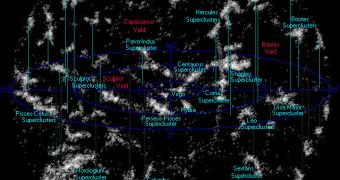About six years ago, telescopes operating in visible-light wavelengths began detecting ancient, massive cosmic blobs. These structures are fuzzy galactic halos located inside galaxy superclusters. Within these blobs, experts are now discovering galaxies that are trillions of times brighter than the Sun.
Cosmic blobs are usually located billions of light-years away, and can only be found inside galactic filaments. The latter are the largest structures that can form in the Universe, accumulating thousands of galaxies in a relatively small region of space.
The main component of these blobs is hydrogen gas, which makes them appear about 10 times larger than the galaxies around which they form. When they were first found, the structures were noticed to be very luminous, but no source of energy could be detected.
In recent studies, conducted using the National Astronomical Observatory of Japan's 8.2-meter Subaru telescope in Hawaii, astronomers gathered enough data to support the idea that extremely bright galactic mergers are in fact powering these blobs, causing them to glow.
Lyman-alpha blobs got their name from the fact that they emit radiation due to the Lyman-alpha emission line of hydrogen gas. If we were to look at such an object from nearby, we would see these emissions in ultraviolet wavelengths.
However, due to the massive distances separating the Milky Way from the blobs, the radiation they emit is distorted by redshift, and translated into longer, optical wavelengths. If our galaxy was even farther away, then we would most likely see these radiation as infrared light.
“It is possible that extremely bright galactic mergers lie at the center of all the mysterious blobs, but we still don't know how they fuel the blobs themselves,” explains researcher Dr. Harry Teplitz.
“It's like seeing smoke in the distance and now discovering that it's a forest fire, not a house or car fire, but still not knowing whether it was caused by lightning or arson,” he adds. Teplitz is based at the Spitzer Science Center, which is managed by the California Institute of Technology (Caltech), Daily Galaxy reports.
While looking more than 11 billion years in the past, the NASA Spitzer Space Telescope was able to detect massive blobs forming during a time when the Universe was just reaching its reionization epoch.
Some of the halos reached diameters of 55,000 light-years. This is very massive for such an early time, considering that the Milky Way is now 100,000 light-years across, after billions of years of evolution, and several galactic mergers.

 14 DAY TRIAL //
14 DAY TRIAL //